| [1] Staiger MP, Pietak AM, Huadmai J, et al. Magnesium and Its Alloys as Orthopedic Biomaterials: A Review. Biomaterials. 2006;27(9):1728-1734.[2] Shao MZ.Chengdu:Sichuan Keji Chbanshe. 1996: 3. 邵美珍.镁的基础与临床[M].成都: 四川科技出版社, 1996: 3.[3] Huang JJ,Ren YB,Zhang BC,et al. Xiyou Jinshu Cailiao yu Gongcheng. 2007;36(6):112-1105. 黄晶晶,任伊宾,张炳春,等.镁及镁合金的生物相容性研究[J].稀有金属材料与工程,2007,36(6):112-1105.[4] Zhang ZY,Ai HJ. Zhongguo Zuzhi Gongcheng Yanjiu yu Linchuang Kangfu. 2008;12(32):6315-6318. 张宗扬,艾红军.AZ31B可降解镁合金的遗传毒性评价:鼠伤寒沙门氏菌营养缺陷型回复突变试验[J].中国组织工程研究与临床康复,2008,12(32):6315-6318.[5] Yang K,Tan LL,Ren YB,et al.Zhongguo Cailiao Jinzhan. 2009; 28(2):26-30. 杨柯,谭丽丽,任伊宾,等.AZ31镁合金的生物降解行为研究[J].中国材料进展,2009,28(2):26-30.[6] Huan ZG,Leeflang MA,Zhou J,et al.In vitro degradation behavior and cytocompatibility of Mg-Zn-Zr alloys.J Mater Sci Mater Med.2010;21(9):2623-2635.[7] Gu X,Zheng Y,Cheng Y,et al.In Vitro Corrosion and Biocompatibility of Binary Magnesium Alloys. Biomaterials. 2009;30:484-498.[8] Witte F,Abeln I,Switzer E,et al.Evaluation of the skin sensitizing potential of biodegradable magnesium alloys. J Biomed Mater Res A. 2008;86(4):1041-1047.[9] Chen XQ,Yin QS,Zhang Y,et al. Zhongguo Zuzhi Gongcheng Yanjiu yu Linchuang Kangfu. 2010;14(16): 2899-2902. 陈旭琼,尹庆水,张余,等.镁铝合金最大剂量的致敏试验研究[J].中国组织工程研究与临床康复,2010,14(16): 2899-2902.[10] Zhang T,Yin QS,Xia H,et al.Zhongguo Jiaoxing Waike Zazhi. 2012;20(22): 2074-2077. 张涛,尹庆水,夏虹,等.镁合金AZ31B对骨骼肌细胞黏附及增殖的影响[J].中国矫形外科杂志,2012,20(22): 2074-2077.[11] Geng F,Tan LL,Jin XX,et al.The preparation, cytocompatibility, and in vitro biodegradation study of pure b-TCP on magnesium.J Mater Sci Mater Med.2009;20:1149-1157.[12] Li L,Gao J,Wang Y. Evaluation of cyto- toxicity and corrosionbehavior of alkali-heat-treated magnesium in simulated body fluid.Surf Coat Technol.2004;185:92-98.[13] Witte F,Feyerabend F,Maier P, et al.Biodegradable magnesium-hydroxyapatite metal matrix composites. Biomaterials.2007;28 (13): 2163-2174.[14] Yu GN,Pan F,Wen JQ,et al. Zhongguo Jiaoxing Waike Zazhi. 2008;16(13): 1015-1018. 于国宁,潘锋,闻久全,等.镁合金体内植入生物安全性的初步研究[J].中国矫形外科杂志,2008,16(13): 1015-1018.[15] Yu GN,Pan F,Wen JQ,et al.Zhongguo Jiaoxing Waike Zazhi. 2008;16 (14): 1091-1093. 于国宁,潘锋,闻久全,等.体外镁合金与小鼠成骨细胞联合培养观察[J].中国矫形外科杂志,2008,16 (14): 1091-1093.[16] Meng XX,Wang G,Wang F,et al.Zhonghua Chuangshang Guke Zazhi. 2009;11(3): 243-246. 孟祥翔,王钢,王飞,等. 新型医用镁合金材料的体外生物相容性研究[J].中华创伤骨科杂志,2009,11 (3): 243-246.[17] Guo L,Liu K,Z SL,et al. Xiyou Jinshu Cailiao yu Gongcheng. 2008;37(6): 1027-1031. 郭磊,刘魁,张世亮,等.氧化镁膜AZ31B镁合金材料的细胞毒性研究[J].稀有金属材料与工程,2008,37(6): 1027-1031.[18] Serre CM,Papillard M,Chavassieux P,et al.In?uence of magnesium substitution on a collagen-apatite biomaterial on the production of a calcifying matrix by human osteoblasts.J Biomed Mater Res.1998;42: 626-633.[19] Gharizadeh N,Moradi K,Haghighizadeh MH.A study of microleakage in class Ⅱ composite restorations using four different curing techniques.Oper Dent.2007;32(4)336-340.[20] Prasanna N,Pallavi Reddy Y,Kavitha S,et al.Degree of conversion and residual stress of preheated and room-temperature composites.Indian J Dent Res.2007; 18(4):173-176.[21] Ghavamnasiri M,Moosavi H,Tahvildamejad N.Effect of centripetal and incremental methods in Class Ⅱ composite resin restorations on gingival microleakage.J Contemp Dent Pract.2007;8(2):113-120.[22] Daronch M,Rueggeberg FA,Moss L,et al.Clinically relevant issues related to preheating composites.J Esthet Restor Dent.2006;18(6):340-350.[23] Zuo L,Bai SL,Pan F,et al.Jiepouxue Zazhi. 2011;34(2): 152-155. 左林,柏树令,潘锋,等.镁合金表面含硅涂层对成骨细胞的黏附、形态和细胞周期的影响[J].解剖学杂志,2011,34(2):152-155.[24] Yang JX,Cui FZ,Lee IS,et al.In vivo biocompatibility and degradation behavior of Mg alloy coated by calcium phosphate in a rabbit model. J Biomater Appl. 2012;27(2): 153-164.[25] Zhang T,Yin QS.Zhongguo Guke Linchuang yu Jichu Yanjiu Zazhi. 2011;3(3):216-219. 张涛,尹庆水.镁合金及其涂层的生物学性能研究进展[J].中国骨科临床与基础研究杂志,2011,3(3):216-219.[26] Guo L,Liu K,Gao XY,et al.Zhongguo Xiandai Yixue Zazhi. 2009;19(2):161-163. 郭磊,刘魁,高晓宇,等.磷酸钙涂层的AZ31B 镁合金材料对成骨细胞功能的影响[J].中国现代医学杂志,2009,19(2):161-163.[27] Xu L,Pan F,Yu G,et al.In vitro and in vivo evaluation ofthe surface bioactivity of a calcium phosphate coated magnesium alloy. Biomaterials. 2009;30(8):1512-1523.[28] Gao JC,Qiao LY,Wang Y,et al.Xiyou Jinshu Cailiao yu Gongcheng. 2010;39(2):296-299. 高家诚,乔丽英,王 勇,等.纯镁在动物体内骨诱导性能的研究[J].稀有金属材料与工程,2010,39(2):296-299.[29] Yang C,Yuan G,Zhang J,et al. Effects of magnesium alloys extracts on adult human bone marrow-derived stromal cell viability and osteogenic differentiation.Biomed Mater.2010; 5(4):1-9.[30] Zhang Y,Tao HT,He YH,et al.Zhonghua Shiyan Waike Zazhi. 2010;27(5):640-642. 张岩,陶海荣,何耀华,等.镁锌合金对成骨细胞整合素表达的影响[J].中华实验外科杂志,2010,27(5):640-642.[31] Zhang Y,Tao HT,He YH,et al.Yiyao Luntan Zazhi. 2010; 31(10): 1-6. 张岩,陶海荣,何耀华,等,镁锌合金对成骨细胞整合素α5表达的影响[J].医药论坛杂志,2010,31(10):1-6.[32] Zhang Y,Tao HT,He YH,et al.Yiyao Luntan Zazhi. 2010;31(15): 1-7. 张岩,陶海荣,何耀华,等.镁锌合金对成骨细胞整合素α2表达的影响[J].医药论坛杂志,2010,31(15):1-7. |
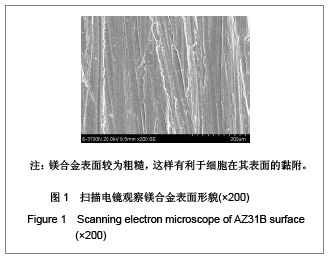
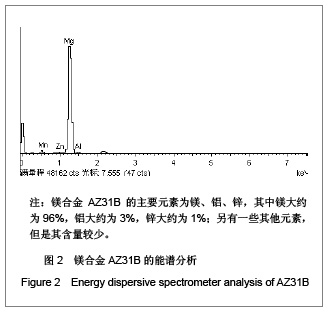
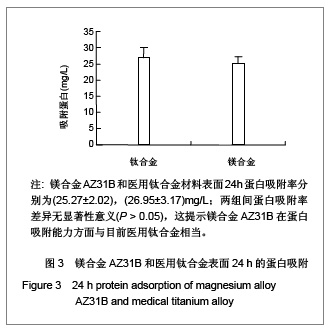
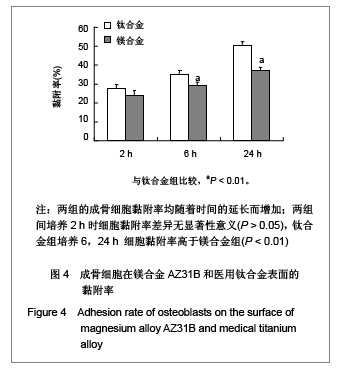
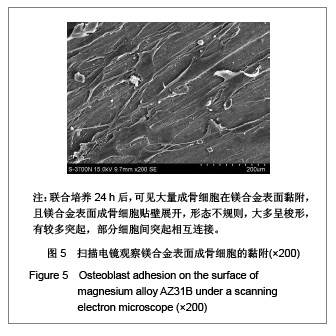

.jpg)